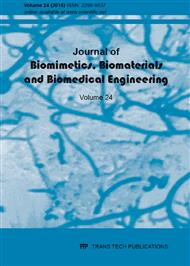[1]
Atkins, K. and M. Thompson, 2011. Effect of textile hygroscopicity on stratum corneum hydration, skin erythema and skin temperature during exercise in the presence of wind and no wind. J. Exerc. Sci. Fit., Vol. 9, No. 2, p.100–108.
DOI: 10.1016/s1728-869x(12)60005-7
Google Scholar
[2]
Dai, J. and D. Shaoxun, 2007. Research on temperature and humidity inside of athletic-shoes. Leather Sci. Eng., 17: 66-68.
Google Scholar
[3]
Feldman, F. and E.L. Nickol, 1984. Normal thermographic standards for the cervical spine and upper extremities. J. Skeletal Radio, 12: 235-249.
DOI: 10.1007/bf00349505
Google Scholar
[4]
Gold, J.E., M. Cherniack and B. Buchholz, 2004. Infrared thermography for examination of skin temperature in the dorsal hand of office workers. Eur. J. Appl. Physiol., 93(1): 245-251.
DOI: 10.1007/s00421-004-1210-6
Google Scholar
[5]
Han, Z., S. Tang and J. Lai, 2009. The current international research situation and key techniques of cooling garment. China Personal Protect. Equip., 4: 11-14.
Google Scholar
[6]
Johnson, J.M., 1992. Exercise and the cutaneous circulation. Exercise Sport Sci. Rev, 20: 59-97.
Google Scholar
[7]
Kenney, W.L. and J.M. Johnson, 1992. Control of skin blood flow during exercise. Med. Sci. Sport Exercise, 24: 303-312.
DOI: 10.1249/00005768-199203000-00005
Google Scholar
[8]
Kicklighter, T.H., J.R. Edsall and M. Martin, 2011. Effect of moisture-wicking garments on temperature regulation during exercise. Human Kinetics, 16: 9-13.
DOI: 10.1123/ijatt.16.6.9
Google Scholar
[9]
Lu, Q., H. Yang and L. Chen, 2007. Analysis of the skin temperature distribution of infrared thermography of normal youth. Chin. J. Biomedi. Eng., 26: 528-531.
Google Scholar
[10]
Merla, A., P.A. Mattei, D.L. Di and G.L. Romani, 2010. Thermal imaging of cutaneous temperature modifications in runners during graded exercise. Annals. Biomedi. Eng., 38: 158-163.
DOI: 10.1007/s10439-009-9809-8
Google Scholar
[11]
Mujika, l., S. Padilla, D. Pyne and T. Busso, 2004. Physiological changes associated with the preevent taper in athletes. Sports Med., 34: 891-927.
DOI: 10.2165/00007256-200434130-00003
Google Scholar
[12]
Schlee, G., Sterzing, T., and T.L. Milani, 2009. Foot sole skin temperature affects plantar foot sensitivity. Clin Neurophysiol. 120: 1548-1551.
DOI: 10.1016/j.clinph.2009.06.010
Google Scholar
[13]
Swa, R., T. Doi, S. Misu, K. Tsutsumimoto, H. Fujino and R. Ono, 2013. Decreased skin temperature of the foot increases gait variability in healthy young adults. Gait Posture.
DOI: 10.1016/j.gaitpost.2013.01.019
Google Scholar
[14]
Taylor, G.I., M.P. Gianoutsos and S.F. Morris, 1994. The neurovascular territories of the skin and muscles: anatomic study and clinical implications. Plast. Reconstr. Surg., 94: 1-36.
DOI: 10.1097/00006534-199407000-00001
Google Scholar
[15]
Uematsu, S., D.H. Edwin, W.R. Jankel, J. Kozikowski and M. Trattner, 1988. Quantification of thermal asymmetry—part1: normal values and reproducibility. J. Neurosurg., 69: 556-561.
DOI: 10.3171/jns.1988.69.4.0552
Google Scholar
[16]
Vainer, B.G., 2005. FPA-based infrared thermography as applied to the study of cutaneous and stimulated vascular response in humans. Phys. Med. Biol., 50: R63–R94.
DOI: 10.1088/0031-9155/50/23/r01
Google Scholar
[17]
White, M.D. and M. Cabanac, 1995. Respiratory heat loss and core temperatures during submaximal exercise. J. Therm. Biol., 20: 489-496.
DOI: 10.1016/0306-4565(95)00011-k
Google Scholar
[18]
Young, A.J., M.N. Sawka, Y. Epstein, B. Decristofano and K.B. Pandolf, 1987. Cooling different body surfaces during upper and lower body exercise. J. Appl. Physiol., 63: 1218-1233.
DOI: 10.1152/jappl.1987.63.3.1218
Google Scholar
[19]
Zhang, D., Y.G. Zhu, S.Y. Wang, H.M. Ma, Y.Y. Ye, W.X. Fu and W.G. Hu, 2002. Infrared thermoimages display of body surface temperature reaction in experimental cholecystitis. World J. Gastroenterol., 8: 323-327.
DOI: 10.3748/wjg.v8.i2.323
Google Scholar


